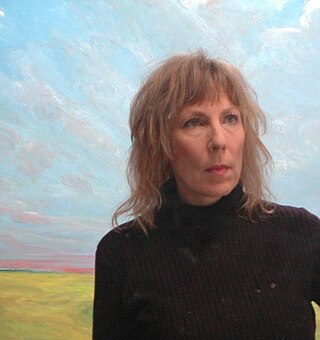1993 art show
A press release prior to the show opening suggests the curators knew the material could be controversial:
Langer's work focuses on the tender and often abject aspects of sexuality and intimacy. His images are largely informed by intuitive personal and social drives, exploring the phenomenon of intimacy where it exists without the compensation of social or cultural consent. In this series of paintings and drawings, Langer often boldly develops a sexual ambiguity that inadvertently addresses our cultural taboos and the formation of morality. [1]
Langer's exhibition at the Mercer coincided with the addition of section 163.1 [3] (the "Child Pornography" section) to the Canadian Criminal Code. That section of the Criminal Code forbids any depiction of a person under the age of 18 engaged in an explicit sexual activity or for a sexual purpose. The law makes no distinction between works of the imagination and works that are based on reality. Langer and the director of the Mercer Union Gallery were arrested by Toronto police, but ultimately the paintings were the only things put on trial. [4]
Well-known figures of the Canadian art community participated in the trial in Langer's defence, including Michael Snow (artist), Avrom Isaacs (gallerist), Dennis Reid (former curator of the National Gallery of Canada), and Ronald Bloore (late artist). They testified that the works exhibited at the Mercer Union had "artistic merit" (a defence provided by s. 163.1 of the Criminal Code). [5] Ultimately the works were exonerated and returned to Langer.
A witness for the Crown prosecuting the case, Ronald Bloore was no stranger to art censorship in Canada. In 1965 his wife, Toronto gallery owner Dorothy Cameron, [6] had been charged and prosecuted in relation to an exhibition of art at her gallery and the results had been catastrophic for her. Eli Langer remembers the apparent willingness of Bloore to testify against his art as being strange, but at trial Ronald Bloore turned the leading questions of the Crown against them, citing the state censorship by the Nazis and calling Langer's artwork "marvellous." Taken aback by the trojan horse witness, the Crown called a recess. Bloore was greeted by an elated Eli Langer and his mother Pearl, and told them, "I've waited 27 years to get these bastards for what they did to my wife!" To this day Langer believes the difficulty of his trial was worth it for the poetic justice done by Ronald Bloore. [7]
Langer's legal victory led to reinterpretation of "prior restraint" to prevent inexperienced police officers from again using an easily obtained "tele-warrant" [8] to carry out similar raids on art exhibitions. Obtaining a warrant now requires the stricter scrutiny of experienced judges. [9]
Current artistic career
His difficult personal experience at the centre of the media sensationalism and legal interpretations of his practice at the time did not long interrupt his interests and development as an artist. He claims that the event was a culmination of testing the boundaries of moral and creative conventions and that the event briefly made art and freedom of expression a household topic across Canada.
According to Langer, his art practice developed beyond the morality issue fight-picking he did as a younger painter and with which he exhausted his willingness for dealing with legal and moralistic entities. He adds that he moved on, seeking clarity and distance from the event and clearing the way for a "more substantive articulation of ideas and art making practice ".
He has shown painting and other works in international exhibitions none of which referred to the art or controversy of the Mercer Union show or subsequent trial.
On January 18, 2008, Langer had his third solo show at Daniel Hug Gallery in Los Angeles. [10] Langer taught painting in both the undergraduate and graduate program at UCLA in 2009. [11] Langer exhibited at Clint Roenisch [12] gallery in Toronto in 2015 and continues to paint and exhibit internationally. [13] [14] [15]

Norval Morrisseau, also known as Copper Thunderbird, was an Indigenous Canadian artist from the Bingwi Neyaashi Anishinaabek First Nation. He is widely regarded as the grandfather of contemporary Indigenous art in Canada. Known as the "Picasso of the North," Morrisseau created works depicting the legends of his people, the cultural and political tensions between native Canadian and European traditions, his existential struggles, and his deep spirituality and mysticism. His style is characterized by thick black outlines and bright colors. He founded the Woodlands School of Canadian art and was a prominent member of the “Indian Group of Seven."
Ronald Langley Bloore, D.Litt LL. D. FRSC was a Canadian abstract artist and teacher. He was a member of the Regina Five.
Mercer Union is a Canadian artist-run centre in Toronto, Ontario, established in 1979 to exhibit contemporary art.

R v Butler, [1992] 1 S.C.R. 452 is a leading Supreme Court of Canada decision on pornography and state censorship. In this case, the Court had to balance the right to freedom of expression under section 2 of the Canadian Charter of Rights and Freedoms with women's rights. The outcome has been described as a victory for anti-pornography feminism and the Women's Legal Education and Action Fund, but a loss for alternative sexualities.
In Canada, appeals by the judiciary to community standards and the public interest are the ultimate determinants of which forms of expression may legally be published, broadcast, or otherwise publicly disseminated. Other public organisations with the authority to censor include some tribunals and courts under provincial human rights laws, and the Canadian Radio-television and Telecommunications Commission, along with self-policing associations of private corporations such as the Canadian Association of Broadcasters and the Canadian Broadcast Standards Council.

Regina Five is the name given to five abstract painters, Kenneth Lochhead, Arthur McKay, Douglas Morton, Ted Godwin, and Ronald Bloore, who displayed their works in the 1961 National Gallery of Canada's exhibition "Five Painters from Regina".
William Ronald Smith, known professionally as William Ronald, was an important Canadian painter, best known as the founder of the influential Canadian abstract art group Painters Eleven in 1953 and for his abstract expressionist "central image" paintings. He was the older brother of painter John Meredith (1933–2000).

Painters Eleven was a group of abstract artists active in Canada between 1953 and 1960. They are associated with the Abstract Expressionist movement.
Legal frameworks around fictional pornography depicting minors vary depending on country and nature of the material involved. Laws against production, distribution, and consumption of child pornography generally separate images into three categories: real, pseudo, and virtual. Pseudo-photographic child pornography is produced by digitally manipulating non-sexual images of real minors to make pornographic material. Virtual child pornography depicts purely fictional characters. "Fictional pornography depicting minors," as covered in this article, includes these latter two categories, whose legalities vary by jurisdiction, and often differ with each other and with the legality of real child pornography.
An obscenity is any utterance or act that strongly offends the prevalent morality of the time. It is derived from the Latin obscēnus, obscaenus, "boding ill; disgusting; indecent", of uncertain etymology. Generally, the term can be used to indicate strong moral repugnance and outrage in expressions such as "obscene profits" and "the obscenity of war". As a legal term, it usually refers to descriptions and depictions of people engaged in sexual and excretory activity.
Graham Stuart Ovenden was an English painter, fine art photographer and writer.
In Canada, child pornography is illegal under Section 163.1 of the Criminal Code and is punishable by up to ten or fourteen years of imprisonment depending on the offence. The Supreme Court of Canada has found child pornography, including the simple possession of child pornography, to not be protected by the Canadian Charter of Rights and Freedoms. In October 2024, a private member's bill was passed which generally retitles references to "child pornography" as "child sexual abuse material". This law is set to take effect in October 2025. Some current law is unenforceable to the extent of exemptions carved out by the Supreme Court of Canada in R v Sharpe.

Edmonton Contemporary Artists' Society (ECAS) is an international artists' exhibition collective founded in 1993, based in Edmonton, Alberta, Canada.

Graffiti in Toronto, Ontario, Canada, is a cause of much disagreement among its residents. Graffiti is seen by some as an art form adding to the Toronto culture; however, others see graffiti as form of vandalism, viewing it as ugly, or as a form of property damage.
Robert Wiens is a Canadian visual artist.

Rae Johnson (1953-2020) was a Canadian painter who lived in Toronto, Canada.
Rebecca Anweiler is a contemporary Canadian visual artist based in Kingston, Ontario. She has been exhibiting works in oil painting, new media and video since 2000. She has taught at Queen’s University at Kingston for 15 years. Most notably her works are in the collections of the Agnes Etherington Art Centre, the City of Toronto, and the University of Lethbridge.
Janice Gurney is a Canadian contemporary artist born in Winnipeg, Manitoba. She graduated University of Manitoba in 1973 with a Bachelor of Fine Arts Honours degree and later received a Master of Visual Studies degree from University of Toronto in 2007 with a collaborative degree in Book History and Print Culture. She went on to get a PhD in Art and Visual Culture at Western University in 2012.
Dorothy Cameron Bloore (1924–2000) was a Canadian art dealer, and installation artist in Toronto, Ontario. Her work is in the Art Gallery of Hamilton, Ontario.
Brent Roe is an artist who uses words and sentence fragments in his paintings to challenge aesthetic and philosophical ideas.





